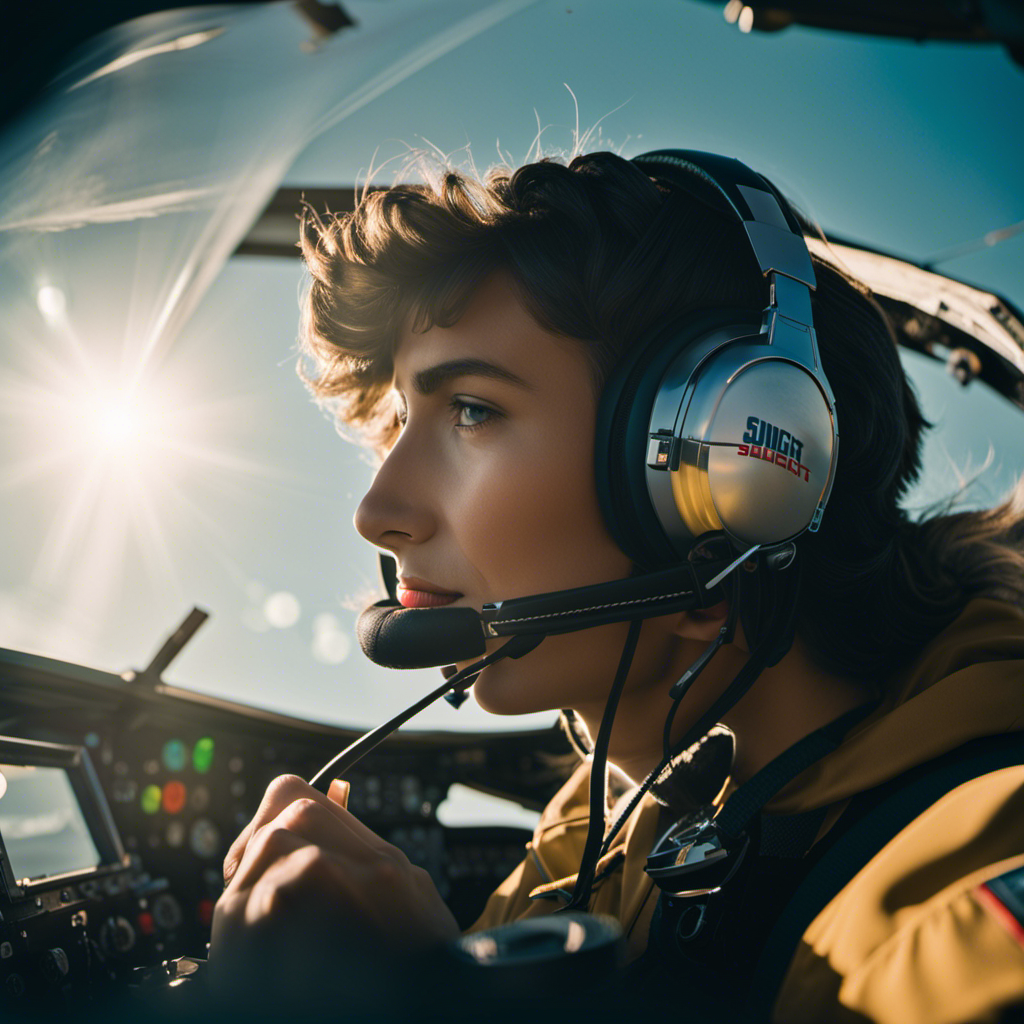As a passionate aviation enthusiast, I have always been intrigued by the exciting world of flying. If you also dream of soaring through the skies as a pilot, this comprehensive guide is tailored to help you begin the exhilarating journey of flight training.
From understanding the basics of flight theory to preparing for the private pilot license exam, this article will provide you with all the necessary information and resources to embark on a successful career in aviation.
So let’s dive in and explore the ins and outs of becoming a pilot!
Key Takeaways
- Understanding flight theory is crucial for making informed decisions in the air and navigating different weather conditions.
- Accreditation and certification of flight schools ensure high-quality education and training.
- The qualifications of flight instructors, including their experience and teaching skills, play a crucial role in training.
- Ground school, classroom instruction, flight simulator training, and practical flying skills are all important components of pilot training.
Understanding the Basics of Flight Theory
Understanding the basics of flight theory is essential for aspiring pilots. Flight dynamics and aerodynamic principles are the foundation upon which successful flying is built.
Flight dynamics refers to the study of how aircraft move through the air, including factors such as lift, drag, thrust, and weight. Aerodynamic principles encompass the forces acting on an aircraft during flight, such as Bernoulli’s principle and Newton’s laws of motion.
By understanding these concepts, pilots can make informed decisions in the air, adjust their flight controls accordingly, and ensure a safe and efficient flight.
Having a solid grasp of flight theory is crucial for pilots to navigate different weather conditions, handle emergencies, and maintain the stability and control of the aircraft.
With this knowledge, pilots can confidently choose the right flight school, where they can further develop their skills and gain practical experience.
Choosing the Right Flight School
When it comes to choosing the right flight school, two key factors that I consider are accreditation and certification.
Accreditation ensures that the school meets certain standards of quality and excellence, while certification ensures that the school has been authorized by the appropriate aviation authorities.
Another important factor to consider is the qualifications of the instructors. I look for instructors who have extensive experience and hold relevant certifications in flight instruction, as their expertise and knowledge play a crucial role in my learning experience.
Accreditation and Certification
Accreditation and certification ensure that flight training schools meet industry standards. Flight schools must undergo a rigorous evaluation process conducted by accrediting bodies such as the Federal Aviation Administration (FAA) or the European Union Aviation Safety Agency (EASA) to meet accreditation requirements. These requirements include a comprehensive review of the school’s curriculum, facilities, safety protocols, and instructor qualifications.
The certification process, on the other hand, involves verifying that the flight school meets specific criteria set by the accrediting body. This may include demonstrating compliance with regulations, maintaining proper documentation, and having qualified instructors on staff.
By obtaining accreditation and certification, flight training schools demonstrate their commitment to providing high-quality education and training to aspiring pilots.
Now, let’s delve into the next section and explore the crucial aspect of instructor qualifications.
Instructor Qualifications
To ensure you receive the best education, it’s important to know the qualifications your flight instructors must meet. When it comes to instructor certification, there are certain requirements they must fulfill to be considered qualified. Here are three key factors to consider:
-
Certification: Your flight instructor should hold a valid instructor certificate issued by the aviation authority in your country. This ensures that they have undergone the necessary training and have met the standards set by the regulatory body.
-
Experience: Look for instructors who have a substantial amount of flight experience. It’s important that they have logged a significant number of flight hours and have a diverse range of flying experiences, including different aircraft types and weather conditions.
-
Teaching Skills: Being a skilled pilot is not enough; your instructor should also possess excellent teaching abilities. They should be able to effectively communicate complex concepts, provide clear instructions, and adapt their teaching style to cater to your individual needs.
Understanding the qualifications your flight instructors must meet is crucial in finding the right mentor to guide you through your training. Now, let’s explore how to navigate the training process smoothly.
Navigating the Training Process
When it comes to pilot training, two essential components are ground school and classroom instruction, as well as flight simulator training.
In ground school and the classroom, aspiring pilots learn the theory and principles of aviation, covering topics such as aerodynamics, navigation, weather patterns, and regulations.
Flight simulator training allows students to apply that knowledge in a simulated environment, practicing various flight scenarios and honing their skills before taking to the sky.
These two aspects of training work hand in hand to provide a solid foundation and prepare pilots for the practical aspects of flying.
Ground School and Classroom Instruction
Before you start flying, it’s important to understand that ground school and classroom instruction will provide you with the necessary knowledge to become a competent pilot. Ground school techniques and classroom engagement strategies play a crucial role in building a strong foundation for your aviation journey. In ground school, you will learn about aviation regulations, meteorology, aerodynamics, navigation, and more. Classroom instruction provides an interactive learning environment where you can ask questions, participate in discussions, and collaborate with fellow students. To evoke emotion and enhance your learning experience, I have created a table that showcases the benefits of ground school and classroom instruction:
| Benefits of Ground School and Classroom Instruction |
|---|
| In-depth knowledge |
| Interactive learning |
| Collaboration |
| Guidance and mentorship |
| Preparation for exams |
Flight Simulator Training
During flight simulator training, you’ll have the opportunity to practice realistic flight scenarios and develop your piloting skills in a safe and controlled environment.
Flight simulators offer numerous benefits for aspiring pilots, including the ability to experience virtual reality training. These advanced technologies provide a highly realistic simulation of flying, allowing you to become familiar with cockpit controls, navigation systems, and emergency procedures.
With virtual reality training, you can gain firsthand experience in handling various weather conditions, engine failures, and other challenging situations. This immersive environment enhances your decision-making skills and improves your ability to handle critical situations during actual flights.
Developing Practical Flying Skills
Pilots should focus on honing their practical flying skills to become proficient in the cockpit. Developing emergency procedures is a crucial aspect of this training. Understanding how to handle unexpected situations, such as engine failures or adverse weather conditions, can make all the difference in ensuring the safety of the flight. By practicing these emergency procedures repeatedly, pilots can build muscle memory and respond effectively in high-pressure situations.
Additionally, honing piloting techniques is essential for smooth and precise flying. This includes mastering maneuvers like takeoffs, landings, and turns, as well as understanding the principles of aerodynamics. By continuously refining these skills, pilots can enhance their overall proficiency and confidence in the cockpit.
Transitioning into the next section, learning aviation regulations and safety procedures is equally important in maintaining a high standard of aviation professionalism.
Learning Aviation Regulations and Safety Procedures
As you delve into the world of aviation regulations and safety procedures, you’ll gain a deeper understanding of the rules and protocols that govern the skies. These aviation safety protocols and understanding airspace regulations are essential for every aspiring pilot. It is crucial to comprehend how to navigate the complex network of rules to ensure safe and efficient flights. One key aspect of aviation regulations is the categorization of airspace, which determines the level of control and restrictions imposed in different areas. Here is a table that outlines the different types of airspace:
| Airspace Type | Description | Example |
|---|---|---|
| Class A | Controlled airspace that extends from 18,000 feet up to the flight level 600 | Flights in the upper atmosphere |
| Class B | Controlled airspace around busy airports with high traffic volume | Airports like JFK or LAX |
| Class C | Controlled airspace around airports with moderate traffic volume | Regional airports |
Understanding these regulations and protocols is essential in maintaining safety and order in the skies. With this knowledge, pilots can ensure they operate within the designated airspace and comply with the necessary procedures. This understanding lays the foundation for gaining experience through solo flights, where pilots can apply their knowledge and skills in real-world scenarios.
Gaining Experience through Solo Flights
Once you’ve obtained the necessary knowledge and skills, solo flights provide you with the opportunity to gain valuable experience and apply what you’ve learned in a real-world setting.
Here are three important aspects of solo flight preparation:
-
Pre-flight Checklist: Before taking off on your own, it’s crucial to go through a thorough pre-flight checklist. This includes inspecting the aircraft, checking fuel levels, reviewing weather conditions, and ensuring all necessary equipment is on board. This preparation helps build confidence and ensures a safe flight.
-
Navigation Skills: Solo flights allow you to put your navigation skills to the test. You’ll have to plan your route, read maps, and use navigation instruments effectively. This helps you develop a strong sense of direction and enhances your ability to navigate in different weather conditions.
-
Emergency Procedures: Solo flights also provide an opportunity to practice emergency procedures. Building confidence through solo flights is crucial for handling unexpected situations like engine failures, instrument malfunctions, or weather changes. You’ll learn to stay calm, make quick decisions, and handle emergencies effectively.
As you gain experience through solo flights, you’ll be ready to advance to advanced flight training, where you’ll further refine your skills and knowledge.
Advancing to Advanced Flight Training
When it comes to advancing in flight training, two key areas to focus on are instrument flying and navigation, as well as multi-engine and jet aircraft training.
Instrument flying and navigation are crucial skills for pilots, allowing them to safely navigate and operate an aircraft when visibility is limited.
Multi-engine and jet aircraft training, on the other hand, provides pilots with the necessary knowledge and skills to handle more complex and advanced aircraft, preparing them for a wider range of flying opportunities.
Mastering these key points will not only enhance a pilot’s capabilities but also open up new possibilities in their aviation career.
Instrument Flying and Navigation
Instrument flying and navigation are crucial skills for pilots to master in order to safely navigate through adverse weather conditions. These skills become particularly important when visibility is limited, such as during fog, rain, or low cloud cover.
To ensure a smooth and safe flight, pilots rely on instrument flying techniques and advanced navigation methods. These techniques include using instruments such as the altimeter, airspeed indicator, and attitude indicator to maintain precise control of the aircraft.
Additionally, pilots utilize advanced navigation methods like GPS and VOR (VHF Omnidirectional Range) to accurately determine their position and navigate along their intended flight path.
These tools and techniques are essential for pilots to confidently navigate through challenging weather conditions and ensure the safety of their passengers and aircraft.
As pilots progress in their training, they will also learn about multi-engine and jet aircraft training, which further expands their capabilities and opens up new opportunities in the aviation industry.
Multi-Engine and Jet Aircraft Training
After gaining proficiency in instrument flying and navigation, the next phase of my air flight training involved multi-engine and jet aircraft training. This stage of training was both exciting and challenging as it introduced me to the complexities of handling larger, more powerful aircraft.
Multi-engine training provided me with the skills necessary to operate aircraft with multiple engines, focusing on engine management, systems operation, and emergency procedures. Additionally, jet aircraft handling was a significant aspect of this training, which involved mastering the unique characteristics of jet engines, such as high-speed takeoffs and landings, as well as advanced navigation systems.
Learning to fly these sophisticated machines was an incredible experience that prepared me for the next step in my journey towards obtaining my private pilot license.
Now, let’s delve into the essential aspects of preparing for the private pilot license exam.
Preparing for the Private Pilot License Exam
To ace the Private Pilot License Exam, you’ll need to study diligently and practice regularly. It’s important to familiarize yourself with the private pilot license requirements and understand what’s expected of you during the exam. Here are some tips for exam success:
-
Stay organized: Create a study schedule and stick to it. Break down the material into smaller, manageable sections.
-
Utilize resources: Take advantage of online study guides, practice exams, and textbooks. Join study groups or find a mentor who can provide guidance.
-
Practice flying: The exam will test your knowledge and practical skills. Spend time in the air, practicing maneuvers, navigation, and emergency procedures.
Preparing for the Private Pilot License Exam can be challenging, but with dedication and perseverance, you can succeed.
Once you’ve obtained your license, you’ll be one step closer to pursuing a rewarding career in aviation.
Pursuing a Career in Aviation
Once you’ve obtained your private pilot license, you’ll be able to pursue a fulfilling career in aviation. The aviation industry offers a wide range of career opportunities, from commercial airline pilot to flight instructor, air traffic controller, and aviation manager. To give you an idea of the potential career paths in aviation, here’s a table outlining some of the industry trends and corresponding job roles:
| Industry Trend | Career Opportunity |
|---|---|
| Growth in air travel | Commercial airline pilot |
| Technological advancements | Aviation engineer |
| Demand for drone pilots | Drone pilot |
| Increase in air traffic | Air traffic controller |
| Focus on safety | Aviation safety inspector |
| Growth in aviation education | Flight instructor |
As you can see, there are various career options available in aviation, catering to different interests and skill sets. Continuing education and professional development are crucial in this field to stay updated with the latest advancements and regulations.
Continuing Education and Professional Development
Continuing your education and staying updated with industry advancements is crucial for professionals in aviation.
As a pilot, I understand the importance of continuing education to enhance my skills and knowledge. In this rapidly evolving field, it is imperative to stay ahead of the curve.
By participating in continuing education programs, I can keep up with the latest technological advancements, regulatory changes, and best practices in aviation. It also provides opportunities for professional networking, allowing me to connect with fellow pilots and industry experts. These connections can be invaluable for sharing insights, experiences, and career opportunities.
Whether it’s attending seminars, workshops, or online courses, continuing education enables me to grow as a pilot and stay relevant in the dynamic aviation industry.
Frequently Asked Questions
What are the physical requirements to become a pilot?
To become a pilot, you need to meet certain physical requirements. These include having good physical fitness to handle the demands of flying and having excellent eyesight to ensure clear vision during flights.
How much does flight training typically cost?
Flight training financing can vary greatly depending on the type of program and location. Scholarships and grants can help offset costs, but it’s important to consider hidden expenses such as exams, books, and equipment.
Can I take breaks during flight training?
Yes, you can take breaks during flight training. It’s important to have a well-balanced schedule that allows for rest and relaxation. Taking breaks helps maintain focus and prevents burnout, ensuring a successful training experience.
Are there any age restrictions for becoming a pilot?
There are age restrictions for becoming a pilot. In order to obtain a pilot’s license, you must be at least 16 years old to fly solo and 17 years old to obtain a private pilot’s license.
How long does it usually take to complete flight training?
Flight training usually takes around 6-12 months to complete, depending on the individual’s dedication and availability. It’s like embarking on a journey, where you’ll soar through challenges and milestones to become a skilled pilot.
Conclusion
In conclusion, embarking on the journey of air flight training is like stepping into a world of endless possibilities.
As I take to the skies, I can’t help but feel the exhilaration of soaring through the clouds, the wind rushing through my hair, and the breathtaking views of the world below.
It’s a journey that requires dedication, perseverance, and a thirst for knowledge.
From understanding flight theory to obtaining a private pilot license, every step is a stepping stone towards a fulfilling career in aviation.
So, spread your wings and let your dreams take flight!









